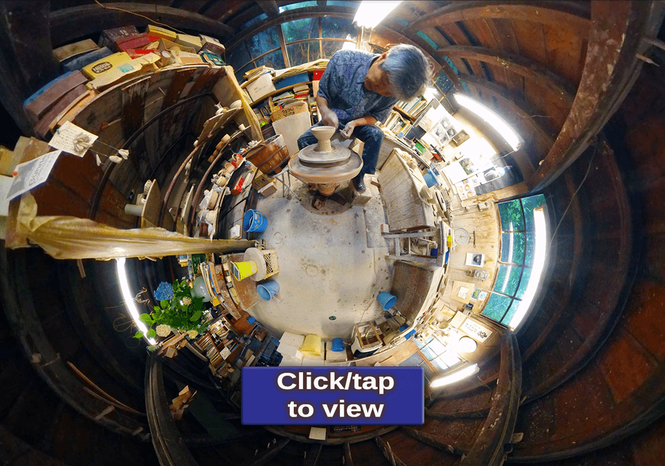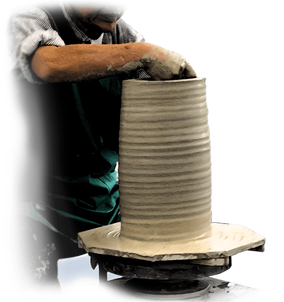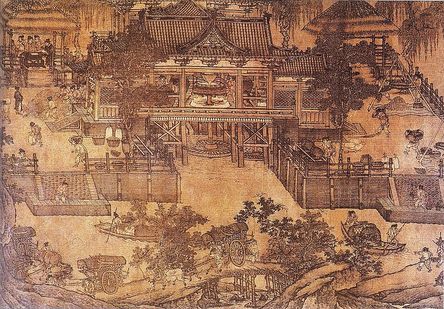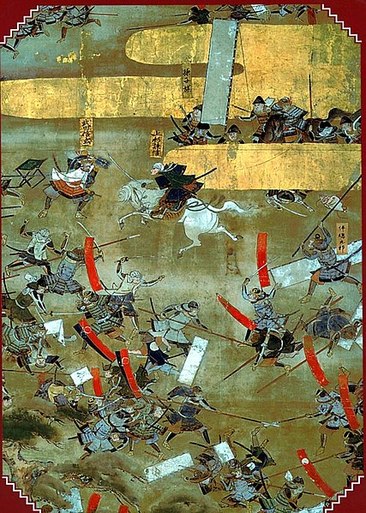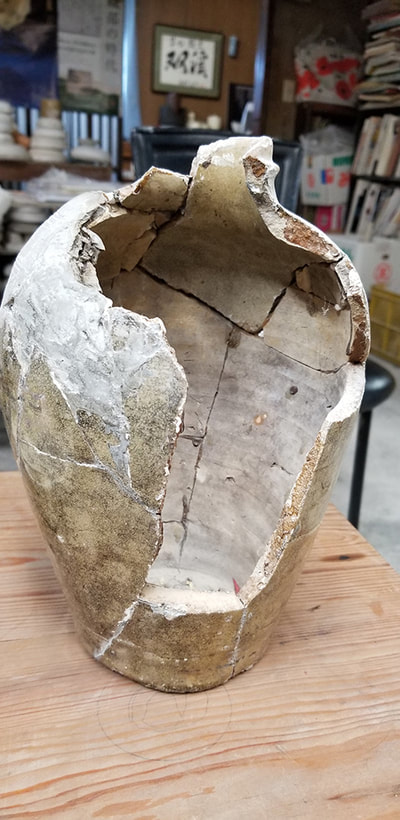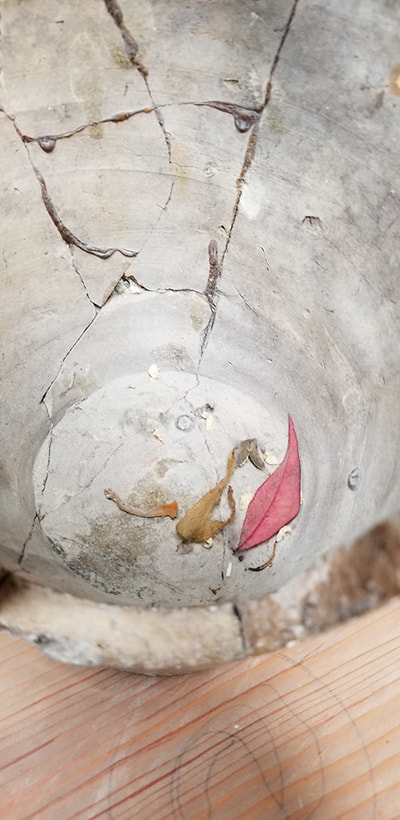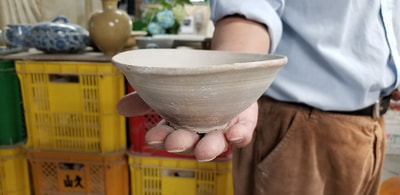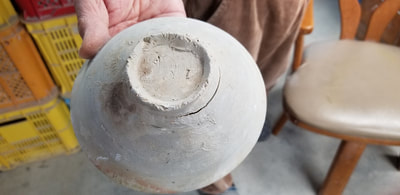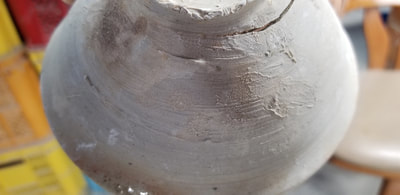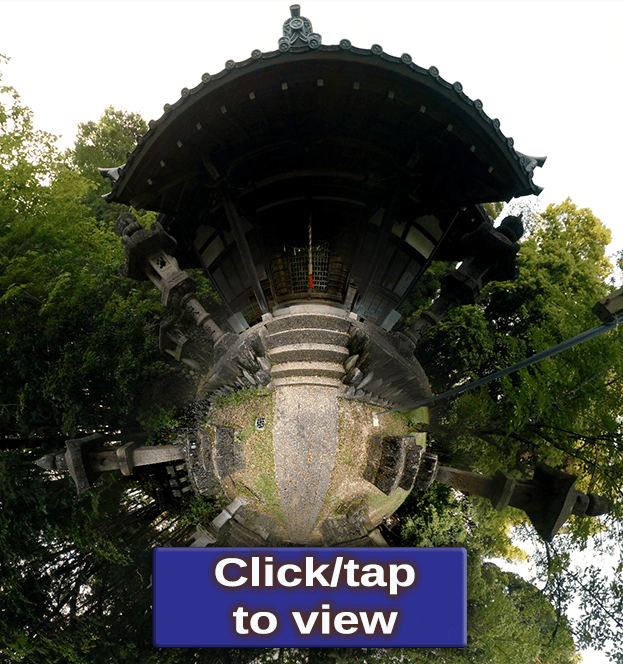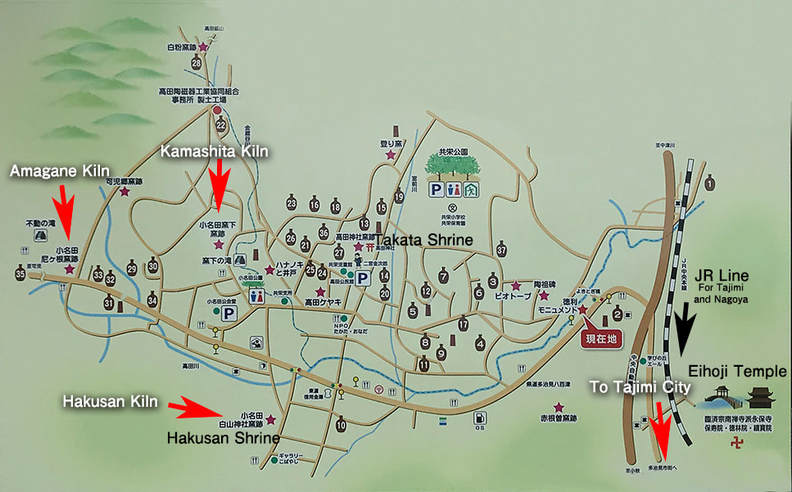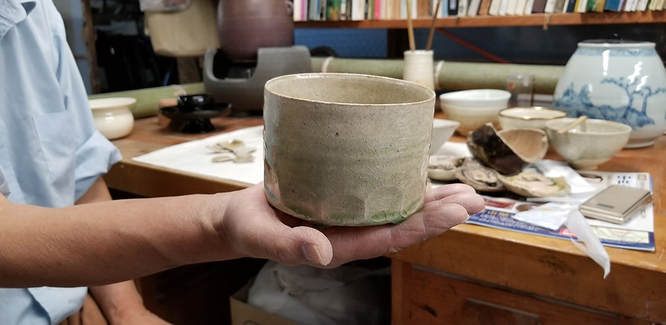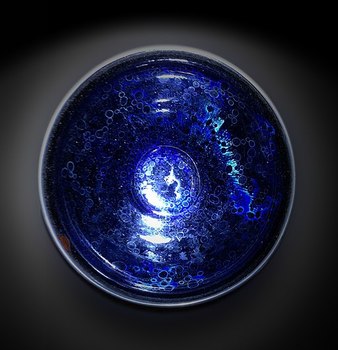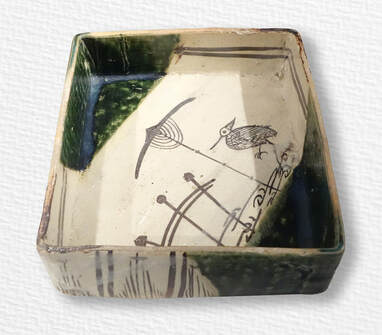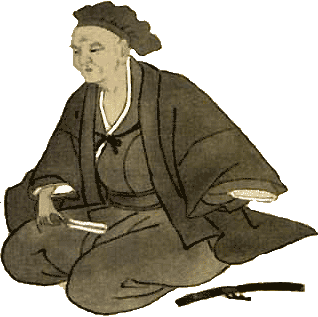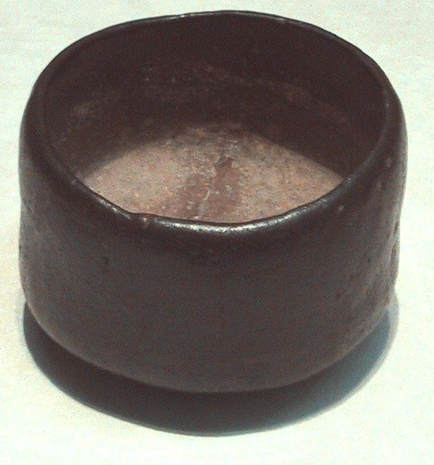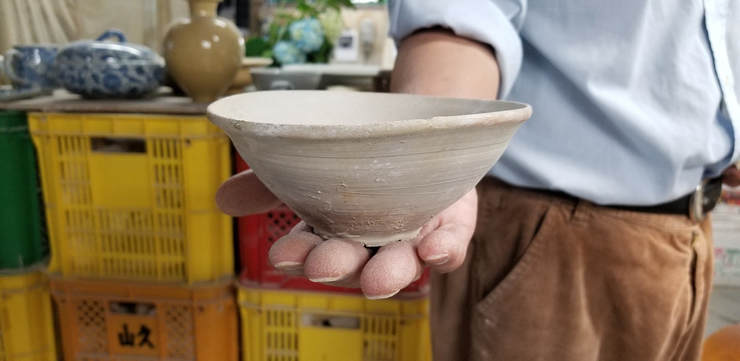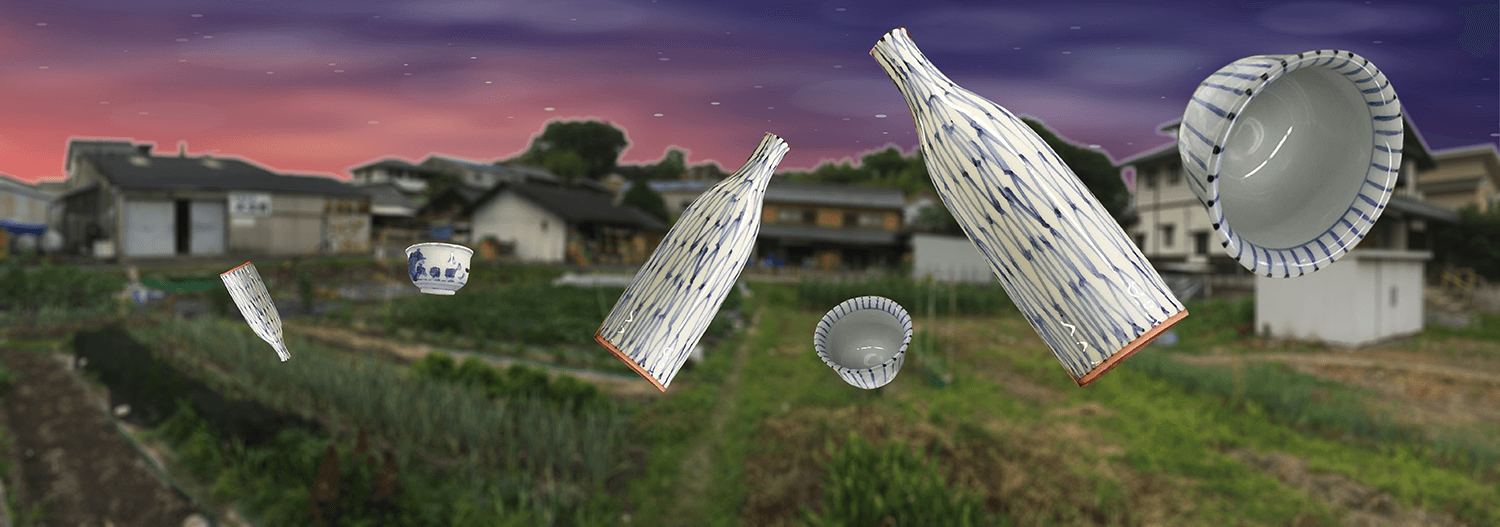The year was 1574. Master potter Kato Kagemitsu (1513-1585) arrive in Mino to set up a new kiln. War is raging in the country, and Kato had escaped from the fighting in the neighbouring Seto region. The now legendary potter introduce styles today regarded as some of the finest in the world of Japanese pottery, in the era now known as Azuchi-Momoyama era (1573 - 1600). But Momoyama was only the end station of a long journey across space and time. Today we will travel back to the starting point.
an idea frozen in time
Pottery has a fascinating quality - that of freezing a moment in time and preserving it for hundreds or even thousands of years. Here is how it works: when the potter puts a lump of clay on his wheel and starts spinning it, “pulling” the shape up from its base as the Japanese say, he transforms a mental form into a physical one with his fingers. Slowly the clay turns into a bowl or a jar, and his fingers leave marks on the creation. Maybe it’s a little bent somewhere. Perhaps there is even a mistake. When he fires the piece, these marks are frozen or burnt into a fixed shape that can resist centuries of wear.
Sokei Aoyama has spent a lifetime deciphering signs in old pottery. He is on a quest of the rediscovery of forgotten techniques. Since childhood, the potter has dug in the earth in Onada and Takata just outside the city of Tajimi. If necessary, he will even smash up an ancient piece to get a better look inside. The potter has been tracking forgotten techniques of the old masters, methods that have travelled over millennia from Song China to Korea, and across the sea to Japan. In Japan they were further shaped by the surrounding society and its ideals, shifting over time due to the needs and desires of the rich and powerful. “A potter, after all”, Aoyama explains, “is an artisan who must put bread on the table. He will make products he can sell.”
Looking for meaning in old marks on Japanese pottery may not be as strange as it sounds:
"In pottery, the Japanese especially admire accidental effects that resemble natural forms. Objects that appear misshapen and glazes that exhibit what would usually be regarded as serious imperfections in the West are admired by the Japanese connoisseur. The Japanese potter liked to reveal the impress of the hand that made the object. Marks, such as the ridges left by the fingers in a newly thrown vessel, were frequently accentuated instead of being obliterated, and marks made by tools were often left untouched."
George Savage, "Japanese Pottery", Encyclopaedia Britannica
a trace leading across the sea
Japanese pottery follows three traditions - one of simplicity and a close connection to nature. It is also intimately connected to Zen Buddhism and the tea ceremony. Since times of old, Tajimi, Toki, Mizunami, and Kasahara, all found in the Tono region of Gifu Prefecture, have flourished as local production areas for Mino ware, which embodies this first tradition. A second tradition is of highly finished and brightly coloured factory ware, with roots in China. Then there is a third tradition, of simple but perfectly formed and glazed stonewares, which also relate more closely to the worlds of Chinese and Korean pottery. "The Song dynasty in China is the origin of the pottery I focus on," Aoyama explains.
The Song dynasty (960–1279) was one of the most advanced societies in the medieval world. It invented gunpowder, a paper money based economy, movable type printing and many other technologies. Its social life was vibrant with all forms of entertainment, pastimes, and places to relax, including tea houses and tea clubs. Chán (Japanese: Zen) priests sipped tea in their monasteries. And they sipped it from beautiful tea cups. It seemed a proper beginning of our talk with Aoyama-sensei, then, to start with a cup of tea served in cups in a style of that originating in China.
The Song dynasty (960–1279) was one of the most advanced societies in the medieval world. It invented gunpowder, a paper money based economy, movable type printing and many other technologies. Its social life was vibrant with all forms of entertainment, pastimes, and places to relax, including tea houses and tea clubs. Chán (Japanese: Zen) priests sipped tea in their monasteries. And they sipped it from beautiful tea cups. It seemed a proper beginning of our talk with Aoyama-sensei, then, to start with a cup of tea served in cups in a style of that originating in China.
In between China and Japan is Korea, where we also find an ancient pottery culture dating back to around 8000 BC. Naturally, China was a huge influence in that region, and from there pottery technology and skilled workers entered Japan in massive waves. "Large numbers of Korean potters ended up in Japan, and they had an enormous influence on our culture,” Aoyama explains.
Times of turmoil
The land to which they arrived was one of great danger and turmoil. The Kamakura era (1185 - 1333 ) saw the establishment of the samurai as a leading class in society. This warrior cast established feudalism met Mongol invasions and plunged the country into civil war. The emperor rose in defiance, only to be unseated and see the nation fall under the control of a new line of military junta commanders - the Ashikaga shogunate.
The new ruling elite - the Ashikaga or Muromachi shogunate - rules the nation from 1336 to 1573. The Ashikaga are weak, and power is increasingly growing among the local lords around the country. Their loyalty grew increasingly strained until it erupted into open warfare in the late Muromachi period, also known as the Sengoku or "warring states" period.
The new ruling elite - the Ashikaga or Muromachi shogunate - rules the nation from 1336 to 1573. The Ashikaga are weak, and power is increasingly growing among the local lords around the country. Their loyalty grew increasingly strained until it erupted into open warfare in the late Muromachi period, also known as the Sengoku or "warring states" period.
It could not have been easy to survive as a peaceful potter during these centuries. As pottery became a status symbol for the powerful and wealthy - not the least as part of the tea ceremony - they were surrounded by a world of political intrigue, assassination, and war. It is at the end of the days of the warring states that Mino ware saw its heyday - according to the official story. It begins when the famous potter Kato Kagemitsu arrives in Mino.
IN SEARCH OF THE ESSENCE OF THE POTTER'S WHEEL
Aoyama's search for the origins of Mino pottery here in Onada is an exercise in experimental archaeology. He is striving to connect to the past with his fingertips. "All my life, starting at 15 when my father let me throw my first bowl, I have been in search of the essence of the potter's wheel. During these 50 years, I have shaped clay on the wheel trying this method or that, firing, repeating, constantly striving towards an expression true to the essence of the potter's wheel. That is my only sales point if you will. My point is that what I make is true to myself, flowing from my heart to my fingertips and into the clay. I have no desire to stray from that path. I have pursued that quest as unrelentingly as a devil."
While Aoyama-sensei strives for self-expression, part of that search is directed towards the roots of Mino ware, the style of pottery for which this area is famous. "You can roughly split the development of pottery in Japan from the Heian era (794 - 1185) into three stages," he explains. "During the Heian days, a style of pottery called shirashi was common. Thin glazing was applied, and the so-called kaiyuto pottery was born. After this comes the era of the yamajawan, a style of pottery that lacked glazing (muyuto), and this continued through the Kamakura period to the middle of the Muromachi period. During Muromachi, in the 1300s, potters in Seto (a neighbouring city to Tajimi) started producing koseto - a type of pottery with thicker glazing (seyuto). These are the roots of glazed Mino ware as we know it today."
To illustrate, Aoyama-sensei fetches an ancient-looking jar from the back of his workshop.
"This is a piece of koseto pottery," he says, tapping his finger on the jar. “They made these in the Kamakura and Muromachi eras. You can see it has glazing.” "It must be priceless," I say. "Not at all," Aoyama-sensei replies. "A man brought it one day and told me I could have it. It was damaged, and I broke it further on purpose, actually, to see how they made it. An intact piece would catch a high price, of course, but not something like this. It is a funerary jar. I think the small white things on the bottom might be human bone."
Aoyama-sensei digs in his workshop again and returns with a small, modest-looking cup.
"This is a yamajawan - an unglazed piece of pottery. This piece is the real thing, made sometime during the Kamakura or Muromachi eras. The oldest known ones we have found in this area date back to the 1350s.
Aoyama-sensei digs in his workshop again and returns with a small, modest-looking cup.
"This is a yamajawan - an unglazed piece of pottery. This piece is the real thing, made sometime during the Kamakura or Muromachi eras. The oldest known ones we have found in this area date back to the 1350s.
"As you can see the edge is not straight. It was straight when it came off the potter's wheel, but this bending happens during the firing. I tried to recreate the pottery and compared to the originals, and when I was sure I had pinned down the methods used I documented them on paper. I research employing recreation of forgotten techniques. On top of that, I integrate what I learn in my creations. This is the way I learned from my father."
But surely there must be academics who disagree with Aoyama's conclusions? "Well, I am in a continuous dialogue with university professors, and if they find my arguments insufficient, they ask me to demonstrate in practice how a piece must have been created."
But surely there must be academics who disagree with Aoyama's conclusions? "Well, I am in a continuous dialogue with university professors, and if they find my arguments insufficient, they ask me to demonstrate in practice how a piece must have been created."
Before the renaissance, there was splendid evolution
"The first kilns in this area started to appear in what is now Tajimi city in the 8th and 9th centuries, and later a kaiyuto kiln in Ohari and Hime in the tenth century. Here in Onada production started in the Kamakura era. A group making kosetokei pottery arrived in the place they used to call Hakusan koyoushi and built their kiln next to the Hakusan Shrine." (see 360 VR image at the top of this page).
"Before Kato's time there was the Kamakuraism, and earlier still Tajimi potters made shirashi style pottery of the Heian era. And before that, they produced sueki pottery, all brilliant in their own way. I look for traces of how potters worked by studying what they have left behind. If you look at old broken cups in the ground at Hakusan Koyoshi, you can see they all have the same kind of glazing. Some of them are stuck together because of a bad firing, that's why they threw them away."
"Before Kato's time there was the Kamakuraism, and earlier still Tajimi potters made shirashi style pottery of the Heian era. And before that, they produced sueki pottery, all brilliant in their own way. I look for traces of how potters worked by studying what they have left behind. If you look at old broken cups in the ground at Hakusan Koyoshi, you can see they all have the same kind of glazing. Some of them are stuck together because of a bad firing, that's why they threw them away."
There was a centuries long-production of two types of pottery here in Onada and Takata," Aoyama-sensei explains. "The Hakusan and Kamashita potters made the so-called kensan, a type of karamono tenmoku tea bowls true to the traditional style from the Song dynasty in China (Note 1). Then there were others influenced by the wabi-sabi philosophy first introduced as an element of the tea ceremony by Murata Shukō [also pronounced Jukō] (1423–1502). They produced shukō tenmoku or haikasugi tenmoku tea bowls. The cups were used as tea ceremony utensils for the upper class and wealthy merchants. The Amagane kiln also started producing tea ceremony utensils - tsutsugata chawan (tsutsugata teacups). Until that time, tenmoku was the only type of pottery produced here. It's the oldest style of pottery made here, with a history going back to the Kamakura era."
The more one studies Chinese and Japanese pottery the more the image of a Chinese ideal of regular forms and perfect glazes begins to contrast with the rustic imperfection many of us associate with Japanese aesthetics today. One example of the former is the Chinese tenmoku teacups that were in vogue in Japan in Murata's time - an ideal he began to balance with native Japanese utensils.
The more one studies Chinese and Japanese pottery the more the image of a Chinese ideal of regular forms and perfect glazes begins to contrast with the rustic imperfection many of us associate with Japanese aesthetics today. One example of the former is the Chinese tenmoku teacups that were in vogue in Japan in Murata's time - an ideal he began to balance with native Japanese utensils.
"Murata's legacy is enormous," Aoyama continues. "He introduced the idea of wabi-sabi in the tea ceremony. This is the origin of preference for the rustic simplicity, minimalism and imperfection of wabicha (the wabi tea ceremony). 'A moon edge slightly covered by clouds is more beautiful than one which is a perfect circle' as Murata puts it in his writings. Pottery with somewhat crooked, bent lines became fashionable, and the potters here in Onada had the skill to produce such crooked wares."
The curved lines and imperfections idealised by Murata made a dramatic visual departure from the sombre and monochrome with the event of the Renaissance of Mino ware. This almost shocking, wild outburst of random lines and shapes materialised throughout the late Momoyama (1573–1615) and early Edo periods (1615–1868). Its most famous brand is without no doubt Oribe ware.
The curved lines and imperfections idealised by Murata made a dramatic visual departure from the sombre and monochrome with the event of the Renaissance of Mino ware. This almost shocking, wild outburst of random lines and shapes materialised throughout the late Momoyama (1573–1615) and early Edo periods (1615–1868). Its most famous brand is without no doubt Oribe ware.
Still, wabi-sabi is far from gone. When I Google to see what the world has to say, I hit a page titled "Goodbye Hygge, Say Hello to the Wabi-Sabi Design Trend". Murata's ideas that extended to interior design and space in the form of the tea house and its spiritual environment seems to still be going strong in contemporary design magazines.
The wabi-sabi style continued to thrive even after the Mino ware Renaissance, as this bowl from the Azuchi-Momoyama period illustrates.
"The Renaissance was fantastic, but as you can see there is a long and hugely important tradition carried on by Tajimi kilns before the legendary Kato set foot here! It's undeniable that the Momoyama pottery shines brightest because at that time Japanese culture bloomed and influenced pottery more than ever. It was the time of Shino pottery - a huge change much like the Renaissance in Europe. Choseki (English: feldspar) stone was introduced for the first time, a technology revolution. The stone was made into a powder and used as an ingredient for the glazing of the pottery. Still, what I find most interesting is this, he says and points to the broken yamajawan. This is the inspiration for my production."
"One mustn't forget, Aoyama-sensei notes, "that the crooked Japanese designs that are so famous around the world today came only after Furuta Oribe appears on the pottery scene in Japan around 1600. His name became the brand for the style - Shino Oribe pottery. But if you ask me, I believe Oda Nobunaga himself likely used the older, slightly crooked tenmoku pottery. The type made here in Onada. Tetsu tenmoku pottery has been discovered in the ruins of Oda's house in Gifu. I want to go there and take a look at it and compare to the findings here. If they are similar, there can be no doubt."
"So you can see now that this area is truly a fascinating place for someone interested in classic Japanese pottery. Ironically, most people are unaware of it. It's origins trace all the way back to the Song dynasty and later the arrival of Korean potters in southern Japan."
"So you can see now that this area is truly a fascinating place for someone interested in classic Japanese pottery. Ironically, most people are unaware of it. It's origins trace all the way back to the Song dynasty and later the arrival of Korean potters in southern Japan."
In the second part of this story, we will delve deeper into tenmoku, more specifically shiro tenmoku (white tenmoku). It is the subject Aoyama-sensei has spent most of his research on. Much of what you will learn has not been available to an English speaking audience before.
See you then!
See you then!
notes
- Karamono tenmoku is a general term for tenmoku from mainland Asia. Tenmoku made in Japan is called watenmoku. (Wa is the ancient name for Japan).
images
- Scan of author's book by Patricia Ebrey, the Cambridge Illustrated History of China (1999) Author: PericlesofAthens, from Wikimedia Commons
- Battle of Kawanakajima, Author: Clngre~commonswiki, from Wikimedia Commons
- Yohen tenmoku tea bowl. Author: Key-museo [CC BY-SA 4.0 (https://creativecommons.org/licenses/by-sa/4.0)], from Wikimedia Commons
- Wabi-sabi style tea bowl. Author: Chris 73 / Wikimedia Commons, CC BY-SA 3.0, https://commons.wikimedia.org/w/index.php?curid=48013
